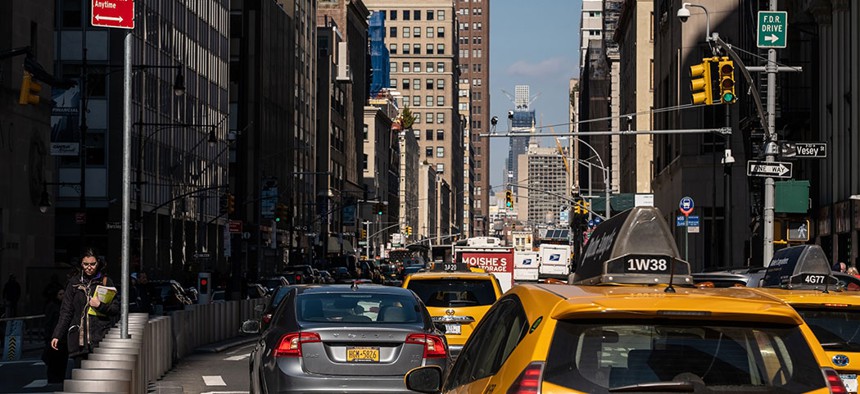New York State
What we know about New York City’s congestion pricing plan
As a part of the new state budget Governor Andrew Cuomo and the state Legislature agreed to enact congestion pricing to help raise revenue for the MTA and reduce traffic in New York City.

Can congestion pricing help decrease traffic in the city? Edi Chen/Shutterstock
As part of the new state budget, Gov. Andrew Cuomo and the state Legislature agreed to enact congestion pricing in New York City to raise revenue for the Metropolitan Transportation Authority and reduce traffic in the busiest parts of Manhattan.
The agreement makes New York City the first city in the nation to implement a congestion pricing plan, which the state has dubbed the Central Business District Tolling Program. However, the legislation leaves a number of unanswered questions. Here is what we know, and don’t know, about the plan so far.
Where will the tolls begin?
As was generally agreed on before the final deal, drivers will be tolled when entering the Central Business District of Manhattan, which is defined as anywhere south of 60th Street. This does not include those driving on the FDR Drive or the Westside Highway.
How much will drivers have to pay?
That question is one of many that remain up in the air as legislators did not specify what the toll price will be. Instead, the legislation establishes a six-person commission called the Traffic Mobility Review Board that will make recommendations for the Metropolitan Transportation Authority to follow on tolls and other issues, like potential credits and exemptions. However, rest assured that if one needs to drive into the Central Business District more than once a day, that person will only be charged once if driving a non-commercial vehicle. A commission put together by Gov. Andrew Cuomo recommended last year a flat rate of $11.52 for cars once per day.
What is this “Traffic Mobility Review Board?”
There is a lot about congestion pricing that has not yet been decided, and that has been left up to this board to decide. The Triborough Bridge and Tunnel Authority, the part of the MTA that will oversee congestion pricing, will appoint the commissioner and other members. Of the six members, New York City Mayor Bill de Blasio will recommend one, one will come from the “Long Island Rail Road Region” and one will come from the “Metro North Region.” Along with deciding on the the actual toll for entering the Central Business District, state lawmakers also tasked the board with coming up with just about every other part involved in the pricing scheme. Some of the considerations the bill suggests the board examine include a discount for motorcycles, credits, discounts or exemptions for those drivers who already paid a bridge or tunnel toll on their way in, peak and off-peak rates. The board will also recommend a plan to implement credits, discounts or exemptions for taxis and ride-hailing app vehicles subject to a surcharge when operating south of 96th Street. During this process, the board will hold public hearings across the regions impacted by the MTA.
When will the tolling begin?
The board must make its recommendations between November 15, 2020 and December 31, 2020, or at least 30 days before the tolling system is implemented. While the Triborough Bridge and Tunnel Authority will decide the official start date of the new tolling system, it will not go into effect until at least January 1, 2021.
Is anything known about potential exemptions?
By and large, not much. The bill language says that emergency vehicles will not be subject to the toll, nor will any qualifying vehicle transporting a person with disabilities. For the latter exemption, one must apply for it through an as-yet-to-be determined process. Additionally, credits will be available for those living within the Central Business Zone, as well as anyone making less than $60,000 a year. Everyone else, including commuters who already pay bridge and tunnel tolls, will have to wait and see what the board recommends.
How will it affect taxis, car services and ride hail apps?
The Traffic Mobility Review Board is required to come up with a plan to offer discounts, credits or exemptions for taxis, car services and rid hail apps, but what those may look like remains unknown. However, the stipulation that non-commercial vehicles only pay the toll once per day ensures that these drivers don’t get charged every time they may need to drive into the Central Business District to drop off or pick up a passenger.
Where will the money go?
The money collected from congestion pricing, as well as the revenue from an expanded mansion tax and an internet sales tax, will go into a lockbox created as part of the budget for the 2020-2024 MTA Capital Program. Congestion pricing is expected to cover $15 billion of the Capital Plan, which current estimates predict will cost between $40 billion and $60 billion. 80 percent of the money within the lockbox will go towards New York City Transit for capital projects related to the city’s buses and subways, with 10 percent set aside for the Long Island Rail Road and the final 10 percent for the Metro North.
NEXT STORY: New York gets an internet sales tax

